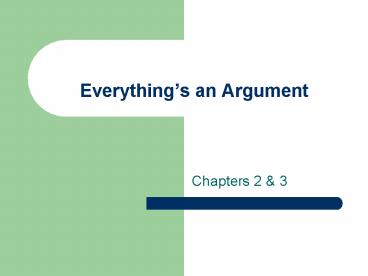Everythings an Argument - PowerPoint PPT Presentation
1 / 25
Title:
Everythings an Argument
Description:
Sojourner Truth, 'Ain't I a Woman?' Four Types of Appeals. Arguments based on Emotion ... Claim: statement of belief or truth. Can be plainly stated (more ... – PowerPoint PPT presentation
Number of Views:206
Avg rating:3.0/5.0
Title: Everythings an Argument
1
Everythings an Argument
- Chapters 2 3
2
Key Issues Regarding Arguments
- Making a connection to readers
- Understanding lines of argument
- Making a claim
- Shaping an argument
- Giving an argument style
- Managing the conventions of argument
3
Making a Connection to Reader
- Writers do not write in a cultural vacuum.
- Writers works are influenced by who they are.
- Race
- Religion
- Gender
- Ethnicity
- Class
- Intelligence
4
Making a Connection to Reader
- Readers perceptions of writer influence their
reception of what has been written. - Must think about readers perceptions, values,
possible prejudices. - Establish some connection with readers.
- Familiarity
- Presenting yourself as authority
5
Making a Connection to Reader
- Look at me! Look at my arm! I have ploughed
- and planted, and gathered into barns, and no
- man could head me. And aint I a woman?... I
- have borne thirteen children, and seen most all
- sold off to slavery, and when I cried out with my
- mothers grief, none but Jesus heard me. And
- aint I a woman?
- Sojourner Truth,
- Aint I a Woman?
6
Four Types of Appeals
- Arguments based on Emotion
- Arguments based on Values
- Arguments based on Character
- Arguments based on Fact and Reason
7
Emotional Arguments
- Designed to appeal to the readers emotions and
feelings. - Can cause readers to think more carefully about
subject. - Persuading reader not to drink and drive
- telling a story of a teen or young mother killed
by drunken driver
8
Emotional Arguments
- Sometimes we have to be wary because emotions can
lead to unwise or impulsive judgments. - Advertising
- Driving a certain car will make you feel superior
to others. - Wearing a certain brand of clothing will make you
feel good about yourself because you are in style
9
Value-Based Arguments
- Closely related to emotional appeals
- Writer either
- Asks reader to live up to higher principles,
respected traditions, or new values - Complains that they have not done so
- Close ties with ceremonial arguments.
- Define or celebrate values/ideals of a society
- Be aware of the values/ideals of community.
10
Character-Based Arguments
- As writer, must seem honest, sincere, and
trustworthy. - Look for evidence of character in arguments
- Who is the author?
- Is writer an authority on topic/knowledgeable
about topic? - Is evidence presented full/complete, not slanted
to writers agenda? - Does writer acknowledge and address opposition?
- Are sources documented?
- REMEMBER these same questions will be used to
analyze your writings.
11
Character-Based Arguments
- As author, you must consider
- Language
- Organization structure
- Sense of authority
12
Facts and Reason-Based Arguments
- Writer must provide enough evidence to support
argument. - Test all assumptions and claims.
- Question every source and authority cited.
- data and information from reliable sources
13
Making a Claim
- Claim statement of belief or truth
- Can be plainly stated (more traditional
arguments). - Can be inferred (in stories, anecdotes, etc.).
- Claims must be attached to reasons that support
it and premises that uphold it to be an argument. - Can have several claims in one essay.
- Look at relationship among them
14
Shaping an Argument
- Arguments must have logical structure, even if
appeal uses emotion, values, or character. - Aristotle asserted arguments had only 2 parts
- Statement (claim)
- Proof (evidence)
15
Giving an Argument Style
- Have to think of the way the evidence is
presented. - Even logical, well-planned argument can be
boring. - Have to tailor your style to the topic
- What is most appropriate
- Style can tell readers what to expect
- Examples on pg. 40
- 1st is straightforward and to-the-point
- 2nd is humorous/tongue-in-cheek
16
READERS CONTEXT
- Must always think about audience or readers when
you present arguments. - Must always address an intended audience.
17
SUBJECT
PURPOSE
CONTEXT
READER
WRITER
18
READERS CONTEXT
- Different kinds of readers
- Ideal reader (exists in authors mind)
- Invoked reader (represented in the text)
- Real reader (ones who actually read text)
19
READERS CONTEXT
- If potential readers do not feel connected to
text in some way, then - They will (probably) not be affected by your
argument or - They will not even continue to read.
20
Establish Credibility
- Ways to establish credibility
- Demonstrate you are knowledgeable
- Highlight shared values
- Refer to common experiences
- Use language to build common ground
- Respect reader
- Almost impossible to guarantee credibility
because readers are varied.
21
Establishing Credibility
- Demonstrate Knowledge
- Show readers you know what you are talking about
- Facts/statistics
22
Establishing Credibility
- Highlight Shared Values
- Find common values with the potential readers
- What community do you share?
23
Establishing Credibility
- Refer to Common Experiences
24
Establishing Credibility
- Build common ground
- Closely related to common experiences
- Establish a connection with readers
- Use pronouns
25
Establishing Credibility
- Respect Readers
- Do not speak down to readers
- Do not use offensive language































